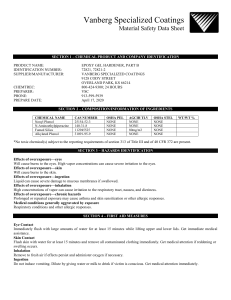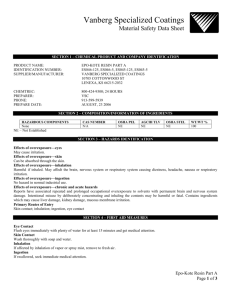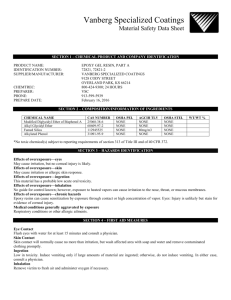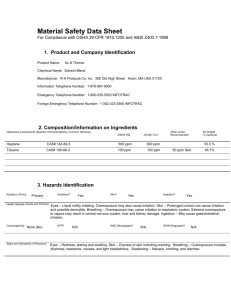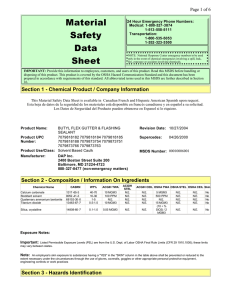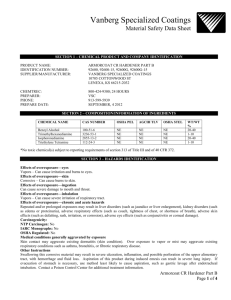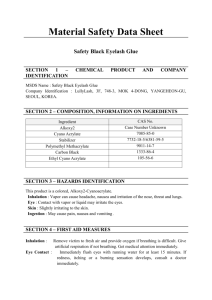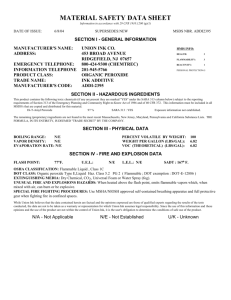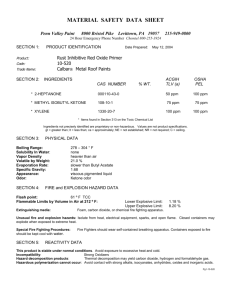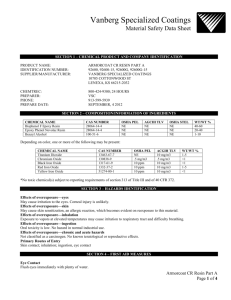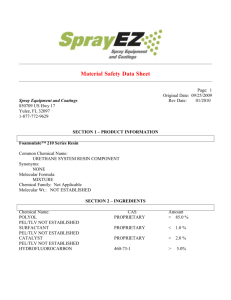section 1 * chemical product and company identification
advertisement
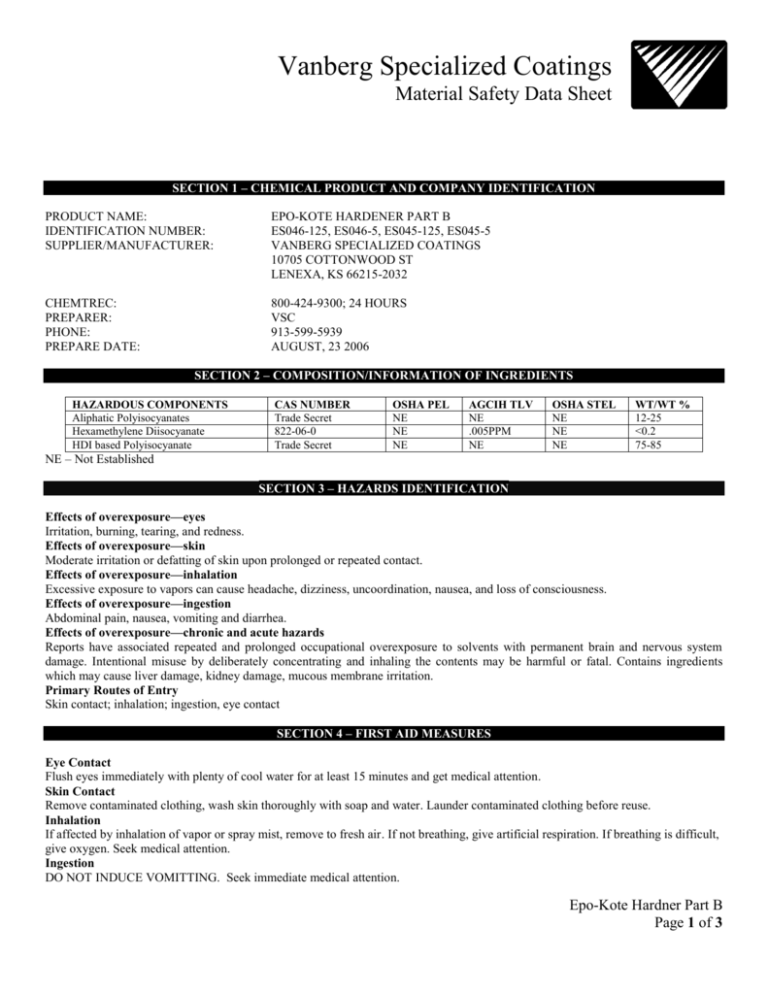
Vanberg Specialized Coatings Material Safety Data Sheet SECTION 1 – CHEMICAL PRODUCT AND COMPANY IDENTIFICATION PRODUCT NAME: IDENTIFICATION NUMBER: SUPPLIER/MANUFACTURER: EPO-KOTE HARDENER PART B ES046-125, ES046-5, ES045-125, ES045-5 VANBERG SPECIALIZED COATINGS 10705 COTTONWOOD ST LENEXA, KS 66215-2032 CHEMTREC: PREPARER: PHONE: PREPARE DATE: 800-424-9300; 24 HOURS VSC 913-599-5939 AUGUST, 23 2006 SECTION 2 – COMPOSITION/INFORMATION OF INGREDIENTS HAZARDOUS COMPONENTS Aliphatic Polyisocyanates Hexamethylene Diisocyanate HDI based Polyisocyanate CAS NUMBER Trade Secret 822-06-0 Trade Secret OSHA PEL NE NE NE AGCIH TLV NE .005PPM NE OSHA STEL NE NE NE WT/WT % 12-25 <0.2 75-85 NE – Not Established SECTION 3 – HAZARDS IDENTIFICATION Effects of overexposure—eyes Irritation, burning, tearing, and redness. Effects of overexposure—skin Moderate irritation or defatting of skin upon prolonged or repeated contact. Effects of overexposure—inhalation Excessive exposure to vapors can cause headache, dizziness, uncoordination, nausea, and loss of consciousness. Effects of overexposure—ingestion Abdominal pain, nausea, vomiting and diarrhea. Effects of overexposure—chronic and acute hazards Reports have associated repeated and prolonged occupational overexposure to solvents with permanent brain and nervous system damage. Intentional misuse by deliberately concentrating and inhaling the contents may be harmful or fatal. Contains ingredients which may cause liver damage, kidney damage, mucous membrane irritation. Primary Routes of Entry Skin contact; inhalation; ingestion, eye contact SECTION 4 – FIRST AID MEASURES Eye Contact Flush eyes immediately with plenty of cool water for at least 15 minutes and get medical attention. Skin Contact Remove contaminated clothing, wash skin thoroughly with soap and water. Launder contaminated clothing before reuse. Inhalation If affected by inhalation of vapor or spray mist, remove to fresh air. If not breathing, give artificial respiration. If breathing is difficult, give oxygen. Seek medical attention. Ingestion DO NOT INDUCE VOMITTING. Seek immediate medical attention. Epo-Kote Hardner Part B Page 1 of 3 SECTION 5 – FIRE FIGHTING MEASURES Flash Point >200º F Method used Closed Cup Flammable Limits In Air By Volume Lower: NE Upper: NE Extinguishing Media CO2, dry chemical, foam, alcohol foam Unusual Fire and Explosion Hazards Vapors are heavier than air and may travel along the ground or be moved by ventilation to ignition sources at locations distant from material handling point. Pressure may build up in containers and create an explosion hazard. Special Fire fighting Procedures Fire fighters must wear self contained breathing apparatus or air masks and full protective clothing. Containers exposed to fire should be kept cool with water spray. Water may be ineffective as an extinguishing agent. SECTION 6 – ACCIDENTAL RELEASE MEASURES Steps to be Taken in Case Material is Released or Spilled Dike spill area. Ventilate area. Avoid breathing of vapors. Use self-contained breathing apparatus or air mask for large spills in a confined area. Eliminate ignition sources. Remove with inert absorbent and non-sparking tools. Avoid contact. SECTION 7 – HANDLING AND STORAGE Precautions to be Taken in Handling and Storing Store in dry area. Keep away from open flames and high temperatures. Minimize contact. Avoid breathing vapors. Practice good industrial hygiene and safe working practices. SECTION 8 – EXPOSURE CONTROLS/PERSONAL PROTECTION Engineering Controls Good general ventilation should be sufficient to control airborne levels. Respiratory Protection Wear appropriate, properly fitted respirator (NIOSH/MSHA approved) during and after application unless air monitoring vapor/mist levels are below applicable limits. Follow respirator manufacturer’s directions for respirator use. Skin Protection Where contact is likely, wear chemical resistant gloves, rubber boots, and chemical safety goggles. Eye Protection Wear chemical safety glasses with side shields or goggles. Other Protective Equipment Nitrile rubber gloves Hygienic Practices Wash hands before eating. Remove contaminated clothing and wash before reuse. Follow all MSDS/label precautions even after container is emptied because they may retain product residues. Avoid prolonged or repeated contact with skin. Avoid contact with eyes, skin, and clothing. SECTION 9 – PHYSICAL AND CHEMICAL PROPERTIES Boiling Range NE Vapor Density NE Vapor Pressure NE VOC Negligible Epo-Kote Hardner Part B Page 2 of 3 Solubility in Water No Appearance & Odor Clear/pale yellow liquid with slight odor Specific Gravity (H20=1) NE Evaporation Rate NE SECTION 10 – STABILITY AND REACTIVITY Conditions to Avoid High heat and moisture Incompatibility Water, amines, strong bases, alcohols, metal compounds and surface active materials. Hazardous Decomposition Products High heat and fire: CO2, CO, oxides of nitrogen, traces of HCN, HDI. Hazardous Polymerization May occur. Contact with moisture or other materials which react with isocyanates or temperatures over 400ºF may cause polymerization. Stability Stable SECTION 11 – HMIS RATINGS Health Flammability Reactivity 2 1 1 SECTION 12 – ECOLOGICAL INFORMATION Exotoxicity NE Environmental Fate NE SECTION 13 – DISPOSAL CONSIDERATIONS Comply with all Federal, State and Local Regulations. SECTION 14 – TRANPORTATION INFORMATION DOT Proper Shipping Name: DOT Technical Name: DOT Hazard Class: DOT UN/NA Number Packing Group: RQ (Reportable Quantity): POLYISOCYANATE POLYISOCYANATE Not regulated by DOT, IMO, or ICAO N/A N/A N/A SECTION 15 – REGULATORY INFORMATION This product contains no hazardous ingredients as defined under the criteria of the Federal OSHA Hazard Communication Standard 29 CFR 1910.1200 SECTION 16 – OTHER INFORMATION The information accumulated herein is believed to be accurate but is not warranted to be whether originating with the company or not. Recipients are advised to confirm in advance of need that the information is current, applicable, and suitable to their circumstances. Epo-Kote Hardner Part B Page 3 of 3
